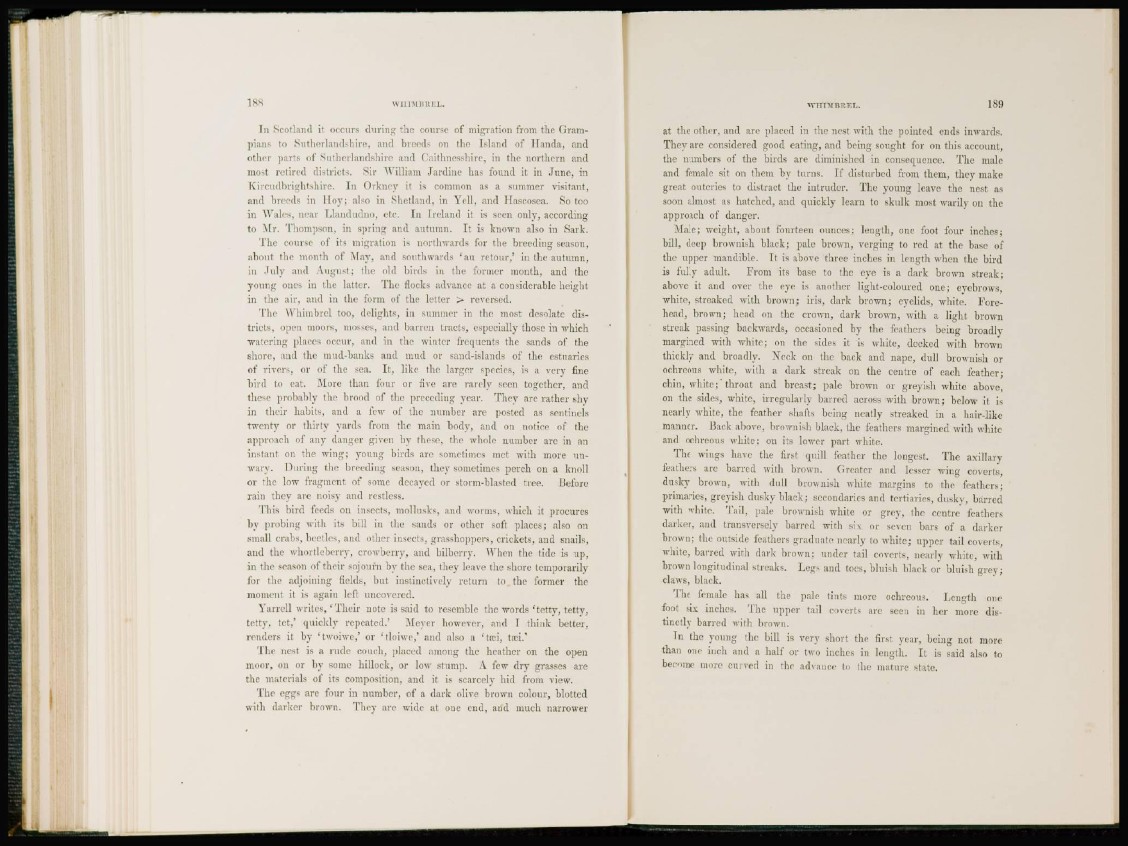
IKS WHUVIBBEL.
I n Scotland it occurs during the course of migration from the Grampians
to Sutterlandshire, and breeds on the Island of ITanda, and
other parts of Sutberlandshire and Caitbnesshire, in the northern and
most retired districts. Sir William Jardinc has found it in June, in
Kircudbrightshire. In Orkney it is common as a summer visitant,
and breeds in Hoy; also in Shetland, in Yell, and Hascosea. So too
in Wales, near Llandudno, etc. In Ireland it is seen only, according
to Mr. Thompson, in spring and autumn. It is known also in Sark.
The course of its migration is northwards for the breeding season,
about the month of May, and southwards ' a n retour,' in the autumn,
in uly and August; the old birds in the former month, and the
young ones in the latter. The flocks advance at a considerable height
in the air, and in the form of the letter > reversed.
The Whimbrel too, delights, in summer in the most desolate districts,
open moors, mosses, and barren tracts, especially those in which
watering places occur, and in the winter frequents the sands of the
shore, and the mud-banks and mud or sand-islands of the estuaries
of rivers, or of the sea. It, like the larger species, is a very fine
bird to eat. More than four or five are rarely seen together, and
these probably the brood of the preceding year. They are rather shy
in their habits, and a few of the number arc posted as sentinels
twenty or thirty yards from the main body, and on notice of the
approach of any danger given by these, the whole number arc in an
instant on the wing; young birds are sometimes met with more unwary.
During the breeding season, they sometimes perch on a knoll
or the low fragment of some decayed or storm-blasted tree. Before
rain they are noisy and restless.
This bird feeds on insects, mollusks, and worms, which it procures
by probing with its bill in the sands or other soft places; also on
small crabs, beetles, and other insects, grasshoppers, crickets, and snails,
and the whortleberry, crowberry, and bilberry. "When the tide is up,
in the season of their sojourn by the sea, they leave the shore temporarily
for the adjoining fields, but instinctively return to the former the
moment it is again left uncovered.
Varrell writes, ' T h e i r note is said to resemble the words Hetty, tetty,
tetty, tot,' quickly repeated.' Meyer however, and I think better,
renders it by 'twoiwe,' or 'tloiwe,' and also a 'trei, tsei.1
The nest is a rude couch, placed among the heather on the open
moor, on or by some hillock, or low stump. A few dry grasses are
the materials of its composition, and it is scarcely hid from view.
The eggs are four in number, of a dark olive brown colour, blotted
with darker brown. They are wide at one end, and much narrower
WHIM BR'FT,. 189
at the other, and are placed in the nest with the pointed ends inwards.
Thev are considered good eating, and being sought for on this account,
the numbers of the birds are diminished in consequence. The male
and female sit on them by turns. If disturbed from them, they make
great outcries to distract the intruder. The young leave the nest as
soon almost as hatched, and quickly learn to skulk most warily on the
approach of danger.
Male; weight, about fourteen ounces; length, one foot four inches;
bill, deep brownish black; pale brown, verging to red at the base of
the upper mandible. It is above three inches in length when the bird
is fully adult. From its base to the eye is a dark brown streak;
above it and over the eye is another light-coloured one; eyebrows,
white, streaked with brown; iris, dark brown; eyelids, white. Forehead,
brown; head on the crown, dark brown, with a light brown
streak passing backwards, occasioned by the feathers being broadlv
margined with white; on the sides it is white, decked with brown
thickly and broadly. Neck ou the back and nape, dull brownish or
ocbreous while, with a dark streak on the centre of each feather;
chin, white;' throat and breast; pale brown or greyish white above,
on the sides, white, irregularly barred across with brown; below it is
nearly white, the feather shafts being neatly streaked in a hair-like
manner. Back above, brownish black, the feathers margined with white
and ocbreous white; on its lower part white.
The wings have the first quill feather the longest. The axillarv
feathers arc barred with brown. Greater and lesser wing coverts,
dusky brown, with dull brownish white margins to the feathers;
primaries, greyish dusky black: secondaries and tertiaries, dusky, barred
with white. Tail, pale brownish white or grey, the centre feathers
darker, and transversely barred with si \ or seven bars of a darker
brown: the outside feathers graduate nearly to white; upper tail coverts,
white, barred with dark brown; under tail coverts, nearly white, with
brown longitudinal streaks. Legs and toes, b l u i s h black or bluish grey;
claws, black.
The female has all the pale tints more ochreous. Length one
foot six inches. The upper tail coverts are seen in her more distinctly
barred with brown.
In the young the bill is very short the first year, being not more
than one inch and a half or two inches in length. It is said also to
become more curved in the advance to the mature state.